Tekstovi srednje težine


The Golden Age of Greece, also referred to as the Classical Period, took place in Greece in the 5th and 4th Centuries BC. This era started when the age of tyranny in Athens finished. Peisistratus, a known tyrant, died in 528 BC. It took until 510 BC for Greek society to stabilize and begin to flourish once again. This was followed by the rule of Alexander the Great, which was a time of remarkable growth for the Greek people. The end of the Golden Age occurred when Alexander passed away in 323 BC. The Golden Age of Greece was one of the most important times in Greek history. It was a time of remarkable cultural growth, and this is what people most often think of when they picture this time period. Greek theater was invented during this time, and plays written by dramatists such as Aeschylus, Aristophanes, Euripides are still performed today. Other things, such as the Olympic Games were also popular during this time period. This is also when democracy was invented and the Athenian Parthenon was built. This is when the noted philosophers, Socrates and Aristotle, were alive. Socrates' method of questioning is still modeled today in today’s schools and universities. Aristotle was one of Socrates’ students who made important contributions to philosophy and intellectual thought. He was also one of Alexander the Great’s tutors when Alexander was a child.

The history of microbiology begins with a Dutch haberdasher named Antoni van Leeuwenhoek, a man of no formal scientific education. In the late 1600s, Leeuwenhoek, inspired by the magnifying lenses used by drapers to examine cloth, assembled some of the first microscopes. He developed a technique for grinding and polishing tiny, convex lenses, some of which could magnify an object up to 270 times. After scraping some plaque from between his teeth and examining it under a lens, Leeuwenhoek found tiny squirming creatures, which he called “animalcules.” His observations, which he reported to the Royal Society of London, are among the first descriptions of living bacteria. Leeuwenhoek discovered an entire universe invisible to the naked eye. He found more animalcules—protozoa and bacteria—in samples of pond water, rain water, and human saliva. He gave the first description of red corpuscles, observed plant tissue, examined muscle, and investigated the life cycle of insects.

The Enlightenment was an intellectual and philosophical movement that dominated the world of ideas in Europe during the 17th to 19th centuries. The Enlightenment emerged out of a European intellectual and scholarly movement known as Renaissance humanism and was also preceded by the Scientific Revolution and the work of Francis Bacon. French historians traditionally date the Enlightenment from 1715 to 1789, from the death of Louis XIV of France until the outbreak of the French Revolution that ended the Ancient Regime. Philosophers and scientists of the period widely circulated their ideas through meetings at scientific academies, Masonic lodges, literary salons, coffeehouses, and in printed books, journals, and pamphlets. The ideas of the Enlightenment undermined the authority of the monarchy and the Catholic Church and paved the way for the political revolutions of the 18th and 19th centuries. A variety of 19th-century movements, including liberalism and neoclassicism, trace their intellectual heritage to the Enlightenment. The Enlightenment included a range of ideas centered on the sovereignty of reason and the evidence of the senses as the primary sources of knowledge and advanced ideals such as liberty, progress, toleration, fraternity, constitutional government, and separation of church and state.


Whereas planetary orbits tend to be nearly circular, those of comets are elliptical`like stretched-out rubber bands. The reappearance of a comet is proportional to the length of its orbit. Halley's comet completes its trek approximately once every 75 years, whereas the lesser magnitude Enke comet makes its rounds in a mere 3.3 years. Other comets, such as Hyakutake (1996), have such elongated orbits that they may pass through the solar system only once every thousand years or more.|There are three constituent parts of a comet: the nucleus, the coma, and the tail. The nucleus of a comet is composed of primarily silicate dust particles embedded in ice; hence, the comet has been informally dubbed a "dirty snowball." Surrounding the nucleus is a vaporous coma of dust and gases that extends for tens of thousands of miles.|When a comet approaches the sun, its tail develops rapidly. Blasted by solar winds and light pressure, gases and dust are forced away from the coma, forming a forked tail. A comet's tail always points away from the sun, somewhat analogous to long hair being blown back by a wind. The tail increases in length as the comet approaches perihelion, its closest distance to the sun. In the 1910 appearance of Halley's comet, the tail was calculated to be some 150 million miles in length. As a comet retreats from the sun, its resplendent tail and glowing coma begin to wane, disappearing completely as the comet nears aphelion, the farthest point away from the sun in its long, elliptical journey.


From ancient times, amber has had a strong allure, with its warm color, resinous feel, translucence, and curious flecks trapped beneath its surface. As early as the Neolithic period, people were carving amber into figures and symbols which were worn as special charms or used for adornment. Today, however, amber has attracted a new audience, scientists who are interested in studying the unusual flecks. These tiny spots in amber are of interest to scientists because many are actually preserved organisms inside the amber.|Though often used in jewelry, amber is not a precious stone, a semi-precious stone, or even a mineral. Instead, it is the fossilized resin, or gum, from trees. It differs from other fossils, however, in that other fossils are generally mineral replacements of original structures, while amber is entirely organic; i.e., it is derived from living organisms. In the millions of years that it takes for amber to form, its composition has stayed substantially the same as that of the resin that formed it.|Large deposits of amber in the Dominican Republic and Mexico are 25 to 30 million years old, and the eastern Baltic region boasts huge deposits of amber that are 15 million years older. The extreme age of amber, coupled with its organic make-up, have caused amber to become the focus of recent scientific interest. Modern technology has been used to determine that the tiny organisms caught in amber have been preserved to a remarkable degree due to the organic nature of the amber; soft tissue, cellular detail, and DNA of ancient organisms have all been preserved, providing information that cannot be obtained from other fossils of that age.


Snow is the precipitation of ice in the form of flakes, clusters, or crystals. Snow crystals are formed in the atmosphere at freezing temperatures when water vapor is condensed to ice without passing through a liquid state. These snow crystals often fall to the ground as individual units, but in warmer regions they clump together as they fall, creating snowflakes. Almost 50 percent of rain was once snow that melted as it entered warmer temperatures on its way to earth. |The study of snow crystals has been going on for more than four centuries. Many people have been intrigued by snow, and in the process of observing its forms and studying its formation, they have created a collection of its images. The first sketch was made in 1550 by Olaus Magnus, archbishop of Uppsala, and in 1635, the first scientific records were made by French philosopher, Rene Descartes. Two centuries later, English meteorologist James Glaisher produced a drawing that is considered the most accurate image made before the development of photomicrography. The pioneer in this advanced technology was Wilson Alwyn Bentley, a farmer in Jericho, Vermont. He began his work in 1885, spending all of his free time outside in the cold taking pictures of snowflakes. By the time of his death 40 years later, he had made 6,000 photos, half of which were later published. |From these studies and the resulting data, science has learned much about the snowflake. Snowflakes are transparent, like glass, and vary in size from .02 inches to .50 inches in diameter. Although an infinite number of snowflakes fall every year, no two have been found that are alike. However, all natural snowflakes are six-sided and consist of flat-plated ice crystals. These hexagonal clumps of ice create a winter wonderland in nearly every part of the world each year.

Every day, millions of shoppers search for the perfect gifts. They buy them for holidays, weddings, birthdays, anniversaries and myriad of other celebrations. Many people relish the opportunity to buy presents because they believe it offers a powerful means to build stronger bonds with their peers. However, many worry that their purchase will disappoint the recipients. Anthropologists believe gift-giving is a positive social. On the other hand, economists describe it as a waste of resources. According to them, people buy presents that recipients would not choose to buy or spend less money to purchase. This is not surprising to social psychologists either. Research has found that people struggle to take account of others’ perspectives. They equate how much they spend with how much with how much recipients will appreciate the gift. However this assumption may be unfounded. According to scientists, gift-givers signal their positive attitude and willingness to invest in their future through gift giving. Ergo, gift-givers believe that with expensive gifts they are sending stronger feelings.

PHI, the Divine Proportion of 1.618, is the ratio of any two sequential numbers in the Fibonacci sequence. If you take the numbers 0 and 1, then create each subsequent number in the sequence by adding the previous two numbers, you get the Fibonacci sequence. For example, 0, 1, 1, 2, 3, 5, 8, 13, 21, 34, 55, 89, 144. If you sum the squares of any series of Fibonacci numbers, they will equal the last Fibonacci number used in the series times the next Fibonacci number. This property results in the Fibonacci spiral seen in everything from seashells to galaxies, and is written mathematically as:  Plants illustrate the Fibonacci series in the numbers of leaves, the arrangement of leaves around the stem, and in the positioning of leaves, sections, and seeds. A sunflower seed illustrates this principal as the number of clockwise spirals is 55 and the number of counterclockwise spirals is 89; 89 divided by 55 = 1.618, the Divine Proportion. Pinecones and pineapples illustrate similar spirals of successive Fibonacci numbers.
Plants illustrate the Fibonacci series in the numbers of leaves, the arrangement of leaves around the stem, and in the positioning of leaves, sections, and seeds. A sunflower seed illustrates this principal as the number of clockwise spirals is 55 and the number of counterclockwise spirals is 89; 89 divided by 55 = 1.618, the Divine Proportion. Pinecones and pineapples illustrate similar spirals of successive Fibonacci numbers.

The worst and longest economic crisis in the modern industrial world, the Great Depression in the United States had devastating consequences for American society. At its worst (1932–1933), more than 16million people were unemployed, more than 5,000 banks had closed, and over 85,000 businesses had failed. Millions of Americans lost their jobs, their savings, and even their homes. The homeless built shacks for temporary shelter—these emerging shantytowns were nicknamed “Hoovervilles,” a bitter homage to President Herbert Hoover, who refused to give government assistance to the jobless. Farmers were hit especially hard. A severe drought coupled with the economic crisis ruined small farms throughout the Great Plains as productive farmland turned to dust and crop prices dropped by 50%. The effects of the American depression—severe unemployment rates and a sharp drop in the production and sales of goods—could also be felt abroad, where many European nations were still struggling to recover from World War I.

The seemingly simple question of “what defines a sport?” has been the fodder for argument and conversation for years, among professional and armchair athletes alike. There seems to be no doubt that vigorous and highly competitive activities such as baseball, football, and soccer are truly “sports,” but when the subject of other activities such as darts, chess, and shuffleboard is broached we find ourselves at the heart of a controversy.
If say, billiards, is not a sport, then what exactly is it? Those who would dispute it to be a sport would respond that it is a simple leisure activity. They would go on to claim a true sport first and foremost requires some form of physical exertion. More to the point, if a player does not break a sweat, what he or she plays is not a sport. Beyond that, more important criteria would be the need for decent hand-eye coordination, and the ever-present possibility of sustaining injury. Billiards only fits one of those specifications (hand-eye coordination), so according to the doubters, it is not a real sport.
To help resolve this dispute, the first text to consult would have to be the dictionary. According to one dictionary, a sport is defined as “a diversion” or a “recreation.” Assuming one strictly adheres to the simple guidelines laid out in that definition, it would seem that almost any activity that provides enjoyment could be classified as a sport. And if, according to the dictionary, watching a sport on television is a sport itself, I guess that would make a couch potato an athlete. Play ball!

According to Kant, knowledge should not be seen as representing objects that exist independently of our judgments. Such objects should not be construed as existing both out there in the world and in our minds behind sensory experience (as rationalists argue), nor as arising directly out of sensory experiences, which then get pieced together by ideas (as empiricists argue). For Kant, neither view concerns dimensions of consciousness, which are crucial for relating the conditions of human knowledge to ethical and moral issues. Human beings are not only able to attribute meaning and value to experience, but can discover that they themselves are the source of those meanings and values. Kant attributes this not only to reason but to imagination. Imagination, for Kant, makes it possible for human beings to discover that they are themselves sources of meanings and values, a discovery necessary for individual consciousness of freedom and for re-solving discrepancies between is and ought in society and history.

Planting a garden is a lot like having a family. Both require a great deal of work, especially as they grow and as the seasons change. As summer days lengthen, your plants become dependent on you for sustenance, much like your children depend on you for food and drink. Like a thirsty child asking for a drink of water, your plants do the same. Their bent, wilted “body” language, translated, issues a demand much the way your child requests milk or juice. When their collective thirsts are quenched, you seethe way they both thrive in your care. The fussy child becomes satisfied, and the plant reaches toward the sun in a showy display. You might also fi nd that you have to clean the space around your plants much like you would pick up toys and clothes that have been thrown helter-skelter in your toddler’s room. Similarly, plants shed spent petals, roses need to be pruned, and weeds need to be pulled. To keep children healthy, parents protect their children against disease with medicine, and gardeners do the same with insect repellent. To nourish them, parents give children vitamins, and gardeners use fertilizer, as both promote healthy growth. As children grow and become adults, they need less and less care. However, here’s where the similarity ends. While plants die and become dormant during winter, children still maintain a vital role in the family unit.

The modern Olympic Games or Olympics are leading international sporting events featuring summer and winter sports competitions in which thousands of athletes from around the world participate in a variety of competitions. The Olympic Games are considered the world's most important sports competition with more than 200 nations participating. They are normally held every four years. The Olympic motto is "Citius, Altius, Fortius", which is Latin for "Faster, Higher, Stronger". The "Olympic rings" are five interlocking rings, colored blue, yellow, black, green, and red on a white field. The symbol was originally created in 1913 by Coubertin. He appears to have intended the rings to represent the five continents: Europe, Asia, Africa, America, and Oceania. The creation of the Olympic games was inspired by the ancient Olympic Games, which were held in Olympia, Greece, from the 8th century BC to the 4th century AD. In the Summer Olympic Games and Winter Olympic Games, Olympic sports are contested. There are also the Paralympic Games for athletes with a disability, the Youth Olympic Games for athletes aged 14 to 18, the five Continental games (Pan American, African, Asian, European, and Pacific), and the World Games for sports that are not contested in the Olympic Games.

The arabesque is a form of artistic decoration consisting of surface decorations or plain lines, often combined with other elements. Within the very wide range of Eurasian decorative art that includes motives matching this basic definition, the term "arabesque" is used consistently as a technical term by art historians to describe only elements of the decoration found in two phases: Islamic art from about the 9th century and onward, and European decorative art from the Renaissance and onward. Interlace and scroll decoration are terms used for most other types of similar patterns. Arabesques are a fundamental element of Islamic art. Arabesque designs on surfaces create a sense of pleasing overall rhythm and patterns. As the Islamic religion spread, arabesques could be found on walls of mosques and palaces, on ceramic tiles and vessels, and on glassware. Some Western arabesques derive from Islamic art, but others are closely based on ancient Roman decorations. In the West, arabesques are essentially found in the decorative arts. Because of the generally non-figurative nature of Islamic art, arabesque decoration is often a very important element and plays a large part in the decoration of architecture.

Opal is a noncrystalline mineral that has been used as a gemstone in numerous cultures for thousands of years. Quantities of high-grade opal have been mined in diverse areas worldwide, including eastern Europe, Australia, and Mexico, as well as in the states of California, Nevada, and Idaho in the United States.|Some varieties of opal contain flashes of a wide spectrum of colors, while others do not. Those types of opal with tiny specks of iridescent color are called precious opal. Varieties without this iridescent coloration throughout are called common opal. It is the precious opal, with its rainbow-like assortment of colors dotting the stone that has been considered gemstone quality over the ages. Precious opal has numerous colors that serve as a background for the iridescent specks, the most valuable of which are black, white, and blue opal, as well as the reddish-brown stone known as fire opal.|In some cultures, precious opal is recognized not only as a gemstone of great attraction but also as an omen of bad luck. Much of the superstition surrounding opal is now believed to have arisen from the tendency of opal to dry out and crack. Opal is a hydrated mineral with a water content that ranges from 1 percent to 21 percent. The hardness of a particular opal depends upon its water content, which can vary and can be particularly low in dry climates. Throughout its long history, the negative superstition surrounding opal has been related to the tendency of opal to crack seemingly spontaneously, without any noticeable justification. A crack in an opal has been viewed as an indication that bad luck is on its way. In reality, though, a seemingly spontaneous crack in a stone is most likely due to a loss of essential water.

A number of staple crops are today quite commonplace in much of the world and feed much of today's population. These staple crops of today originated in different eras and in different parts of the world before spreading throughout the rest of the globe.
Wheat was probably the earliest cereal to have been grown and most likely was a hybrid of wild grasses rather than a single wild grass. It is known to have been cultivated by Mediterranean civilizations 10,000 years ago and was being used as a primary ingredient in baked goods in Mesopotamia as early as 8000 B.C.
Beans are a diverse family of plants that have been cultivated for 8,000 years. Certain types of beans, such as mung and soy, were first cultivated in Asia, while other types of beans, such as string and lima, are thought to have originated in the Americas.
Other crops that originated in the Americas are potatoes and maize, a relative of corn; maize was used extensively beginning around 5000 B.C. in civilizations in what is today Mexico, while the cultivation of the potato developed in civilizations in the Andes at least as early as 100 B.C. Maize and potatoes were staples of the diets of their respective cultures long before they were introduced to Europe in the sixteenth century by European explorers who had discovered them in the Americas.
The cultivation of rice is not as old as the cultivation of wheat, beans, and maize. Rice was first known to have been cultivated in India around 3000 B.C. From there, it later spread to China, Japan, and various countries in Southeast Asia, which are today major producers of the crop.

The apple, a juicy fruit that grows from pink or white flowers, is cultivated widely in orchards across North America. At least two varieties of apples are cultivated together in one orchard due to the fact that the flowers of one type of apple tree must be pollinated by a different variety of apple. The point in the springtime when the apple blossoms appear is the most critical time for apples: there have to be enough bees to pollinate each flower and warm enough weather to facilitate their work. Apple growers watch the temperatures anxiously at this time of year because frozen flowers or fruit spells disaster for the crop. Workers may have to get up at any hour of the night to blow away the cold air with fans, heat the orchard air with fire pots, or wet the trees down to keep the frost away.
The first step in getting apples from orchard to market is to pick them. The picking must be done carefully to ensure that the spur, which produces the fruit, is not damaged. Apples used to be collected in bushel baskets and taken to market, but today bins of apples are trucked to packing houses, where they go through many sortings before they get to the grocery store display. As a first step, the smallest apples, called "chops," are eliminated to make juice. Apples with many flaws, or imperfections, are called "processors"; they are used for pie slices or are made into sauce because of their less-than-perfect appearance. The "fancy" grade apples are stored in a controlled atmosphere; adjusting the oxygen content from 20 percent to 2 percent and keeping the temperature between 31 and 32 degrees Fahrenheit keeps the apples alive but prevents overripening. The humidity is kept around 95 percent so that the apples remain crisp and fresh. Before shipping, the apples are washed, rinsed, dried, and coated with a thin film of hot wax for beautification.
Once the apples have cleared the marketplace, they are put to various uses. Apples are 87 percent water, making them great for juicing. The fresh juice that is made from apples is called cider, and this cider can be fermented into applejack. Apples are not only used to make beverages; they can also be used to make products such as apple butter, vinegar, applesauce, and one of America's favorite desserts, apple pie.

An octopus is a sea creature quite capable of inspiring fear in an unsuspecting swimmer or diver unlucky enough to paddle across one unexpectedly. There is a basis for a healthy fear of an octopus. An octopus is quite strong, in large part due to the suckers on its arms. A common octopus has 240 suckers per arm for a whopping total of 1,920 suckers on all of its arms. Were an octopus to hold onto an object (or a person, for that matter) with all eight of its arms, a quarter of a ton of force would be needed to loosen its grip. Another reason wariness for an octopus is not unwarranted is that some types of octopuses are poisonous. A bite from a venomous type of octopus will undoubtedly cause a stinging pain and may, if left unattended, lead to death within a few hours.
While maintaining a healthy distance from an octopus may be a reasonable position, it is also quite arguable that an octopus poses little threat to humans. An octopus is shy and timid by nature, much more comfortable hiding out in undersea nooks and crannies or burrowing into the sandy bottom than in seeking out conflict. An octopus only strikes out when it feels threatened, when an unexpected invader enters its undersea lair or a potential attacker gets too close. In this situation, an octopus may attack by biting or wrapping its arms around the threatening force.
An octopus, in reality, is much more concerned with avoidance than attack and has a couple of specialized methods of getting away from potential attackers. One method is to eject forceful jets of water. These high-powered streams of water allow an octopus to make a high-speed exit from a dangerous location. Another technique that the octopus uses when eluding a danger is to eject a volume of dark-colored ink. The ink temporarily clouds the water and confuses the sense of smell of the attacker while the octopus quickly flees.
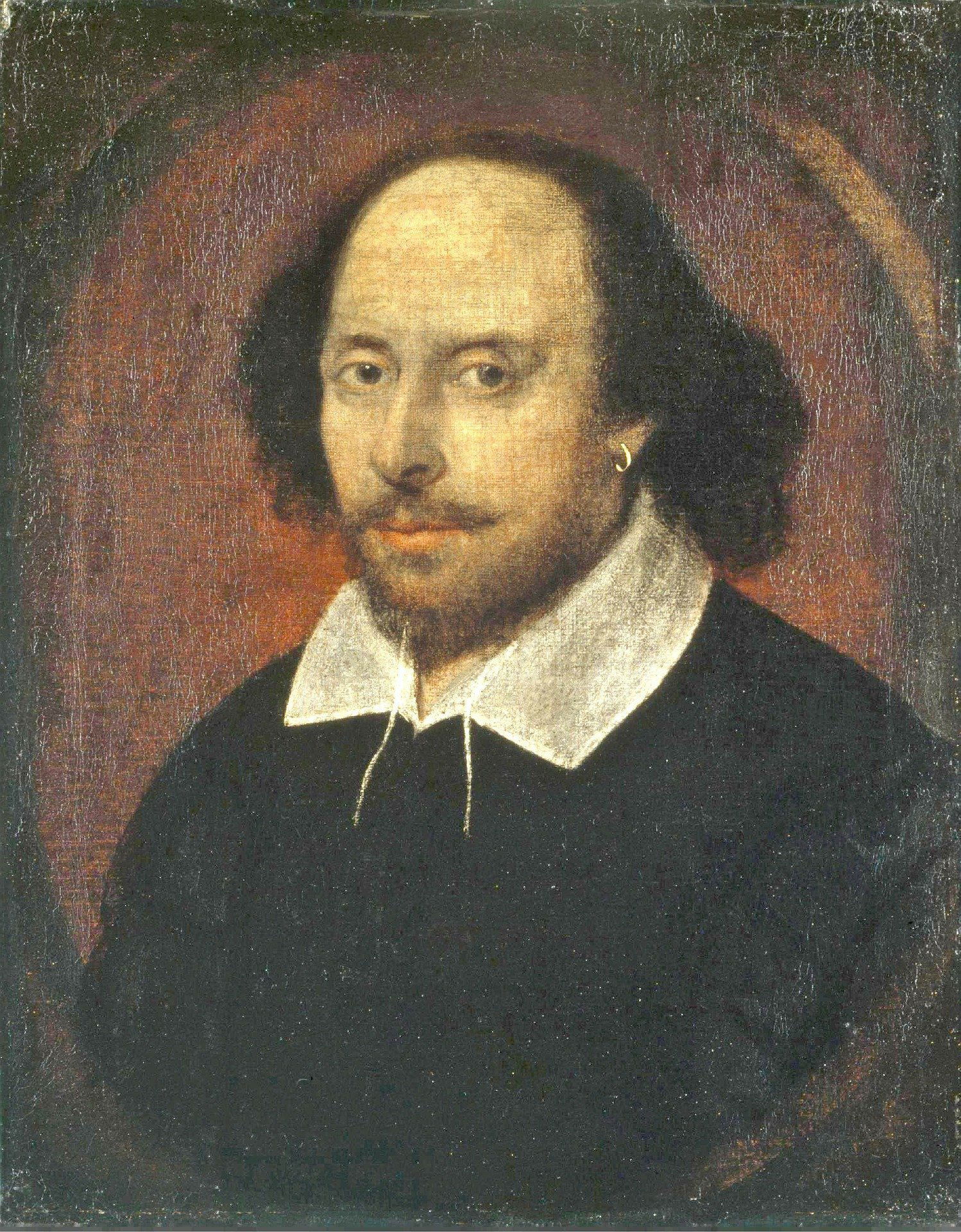
There are many legends about how William Shakespeare got his start in the theater. One states that he began by holding gentlemen's horses at the playhouse door. Others say that he was a servant, a prompter's assistant, or a call boy. In the period between 1592 and 1594, theatrical companies were somewhat disorganized; Shakespeare apparently decided to take advantage of this situation and, casting off the garb of a servant, presented himself as a poet. His two narrative poems, (Venus and Adonis and The Rape of Lucrece, were published during this period, in 1593 and 1594 respectively.
In 1594, Shakespeare made the change from player and poet to actor and playwright. There were two principal theatrical companies at this point in the Elizabethan Age, the Lord Chamberlain's Men and the Lord Admiral's Men. By 1595, Shakespeare was a leading member of one of the two, the Lord Chamberlain's Men, and a sharer in that company. It was a position of both promise and profit inasmuch as the company was soon to become the King's Men with the accession to the throne of King James I.
Known today as one of the greatest playwrights of the English language, Shakespeare was a vital part of the King's Men and played a major role in its success and popularity. In the beginning, his primary role with the company was as a superb actor and great draw. However, after 1603 his name as the principal actor no longer appeared in the credits; from that time on his chief contribution to the company, and to the world, was his plays. His work was the most substantial of the King's Men repertoire during that period and continues to this day to bring the public out to the playhouse.

During a relatively short period at the end of the nineteenth century, George Eastman was instrumental in transforming the labor-intensive and expensive art of photography into a popular and affordable hobby. The phenomenal success that Eastman had in these early years of his business was in most part due to the successful innovation that opened up photography to the population as a whole.|While Eastman was working as a bookkeeper in a bank in Rochester, New York, he spent his leisure time working on a process for making dry plates. By 1880, Eastman had perfected the process. Without leaving his job at the bank, he established the Eastman Dry Plate Company. The business grew so quickly that by 1881 Eastman had given up his job at the bank in order to develop the business.|Changes to simplify the process of taking photographs followed one after another. In 1884, Eastman took a step that made photography a less cumbersome process: he replaced the unwieldy glass plates with paper-backed roll film. Four years later, the hand-held Kodak was introduced. This camera came loaded with enough film to take a hundred photographs and produced round-shaped pictures approximately six centimeters in diameter. Something that made this camera very popular was that a photographer did not need to know how to develop film in order to use it; after using up the film, the photographer sent the loaded camera back to the factory, where the photographs were processed and the camera was reloaded and returned to its owner. In 1892, another innovation, film that could be loaded in the daylight, allowed amateur photographers to load their own film successfully.

The mechanism for evolution was conceived by Charles Darwin in the mid-nineteenth century. He spent time exploring the natural world on different expeditions. From 1831 to 1836, Darwin traveled around the world. His journey included stops at several island chains. On these islands, Darwin observed species of organisms that were clearly similar, but they had distinct differences. Darwin thought that the island species might be all modified from one original mainland species. Darwin conceived a mechanism to explain how and why such changes could take place. He called this mechanism natural selection. Natural selection was an outcome of three principles that happened in nature. First, the characteristics of organisms are inherited. Second, more offspring are produced than are able to survive. Therefore, there is a competition for limited resources in each generation. Third, offspring vary among each other in regard to their characteristics and those variations are inherited. Out of these three principles, Darwin reasoned that offspring with inherited characteristics that allow them to best compete for limited resources will survive and have more offspring than those individuals with variations that are less able to compete. Because characteristics are inherited, these traits will be better represented in the next generation. This will lead to change in populations over generations.

The walnut tree produces wood that is used for countless purposes, and is considered the finest wood in the world. The wood is easy to work with, yet it is very hard and durable—and when it is polished, it produces a rich, dark luster. It also shrinks and swells less than any other wood, which makes it especially desirable for fine furniture, flooring, and even gun stocks. In fact, just about every part of the walnut is unusually hard and strong. The nut of the tree is encased inside a very hard shell, which itself is enclosed in a leathery outer covering called a husk. It requires real effort to break through those layers to get at the tasty meat inside. Yet every part of the walnut is useful to people. The outer husk produces a dark reddish stain that is hard to remove from the hands of the person who opens the nut, and this pigment is widely used in dyes and wood stains. The inner shell is used as an abrasive to clean jet engines. And the meat of the nut is extensively used in cooking, ice cream, flavorings—and just eaten raw. Walnut trees exude a chemical into the soil near their roots which can be poisonous to some trees and shrubs. Fruit trees, for example, will not survive if planted too close to a walnut. Many other plants, such as maple trees or ivy, are not affected by the walnut’s presence, and are well-suited to grow in its vicinity.

The modem comic strip started out as ammunition in a newspaper war between giants of the American press in the late nineteenth century. The first full-color comic strip appeared in January 1894 in the New York World, owned by Joseph Pulitzer. The first regular weekly full-color comic supplement, similar to today's Sunday funnies, appeared two years later, in William Randolph Hearst's rival New York paper, the Morning Journal. Both were immensely popular, and publishers realized that supplementing the news with comic relief boosted the sale of papers. The Morning Journal started another feature in 1896, the "Yellow Kid," the first continuous comic character in the United States, whose creator, Richard Outcault, had been lured away from the World by the ambitious Hearst. The "Yellow Kid" was in many ways a pioneer. Its comic dialogue was the strictly urban farce that came to characterize later strips, and it introduced the speech balloon inside the strip, usually placed above the characters' heads. The first strip to incorporate all the elements of later comics was Rudolph Dirks's "Katzenjammer Kids," based on Wilhelm Busch's Max and Moritz, a European satire of the nineteenth century. The "Kids" strip, first published in 1897, served as the prototype for future American strips. It contained not only speech balloons, but a continuous cast of characters, and was divided into small regular panels that did away with the larger panoramic scenes of most earlier comics. Newspaper syndication played a major role in spreading the popularity of comic strips throughout the country. Though weekly colored comics came first, daily black and-white strips were not far behind. They first appeared in the Chicago American in1904. It was followed by many imitators, and by 1915 black-and-white comic strips had become a staple of daily newspapers around the country.

Every drop of water in the ocean, even in the deepest parts, responds to the forces that create the tides. No other force that affects the sea is so strong. Compared with the tides, the waves created by the wind are surface movements felt no more than a hundred fathoms below the surface. The currents also seldom involve more than the upper several hundred fathoms despite their impressive sweep. The tides are a response of the waters of the ocean to the pull of the Moon and the more distant Sun. In theory, there is a gravitational attraction between the water and even the outermost star of the universe. In reality, however, the pull of remote stars is so slight as to be obliterated by the control of the Moon and, to a lesser extent, the Sun. Just as the Moon rises later each day by fifty minutes, on the average, so, in most places, the time of high tide is correspondingly later each day. And as the Moon waxes and wanes in its monthly cycle, so the height of the tide varies. The tidal movements are strongest when the Moon is a sliver in the sky, and when it is full. These are the highest flood tides and the lowest ebb tides of the lunar month and are called the springtides. At these times the Sun, Moon, and Earth are nearly in line and the pull of the two heavenly bodies is added together to bring the water high on the beaches, to send its surf upward against the sea cliffs, and to draw a high tide into the harbors. Twice each month, at the quarters of the Moon, when the Sun, Moon and Earth lie at the apexes of a triangular configuration and the pull of the Sun and Moon are opposed, the moderate tidal movements called neap tides occur. Then the difference between high and low water is less than at any other time during the month.
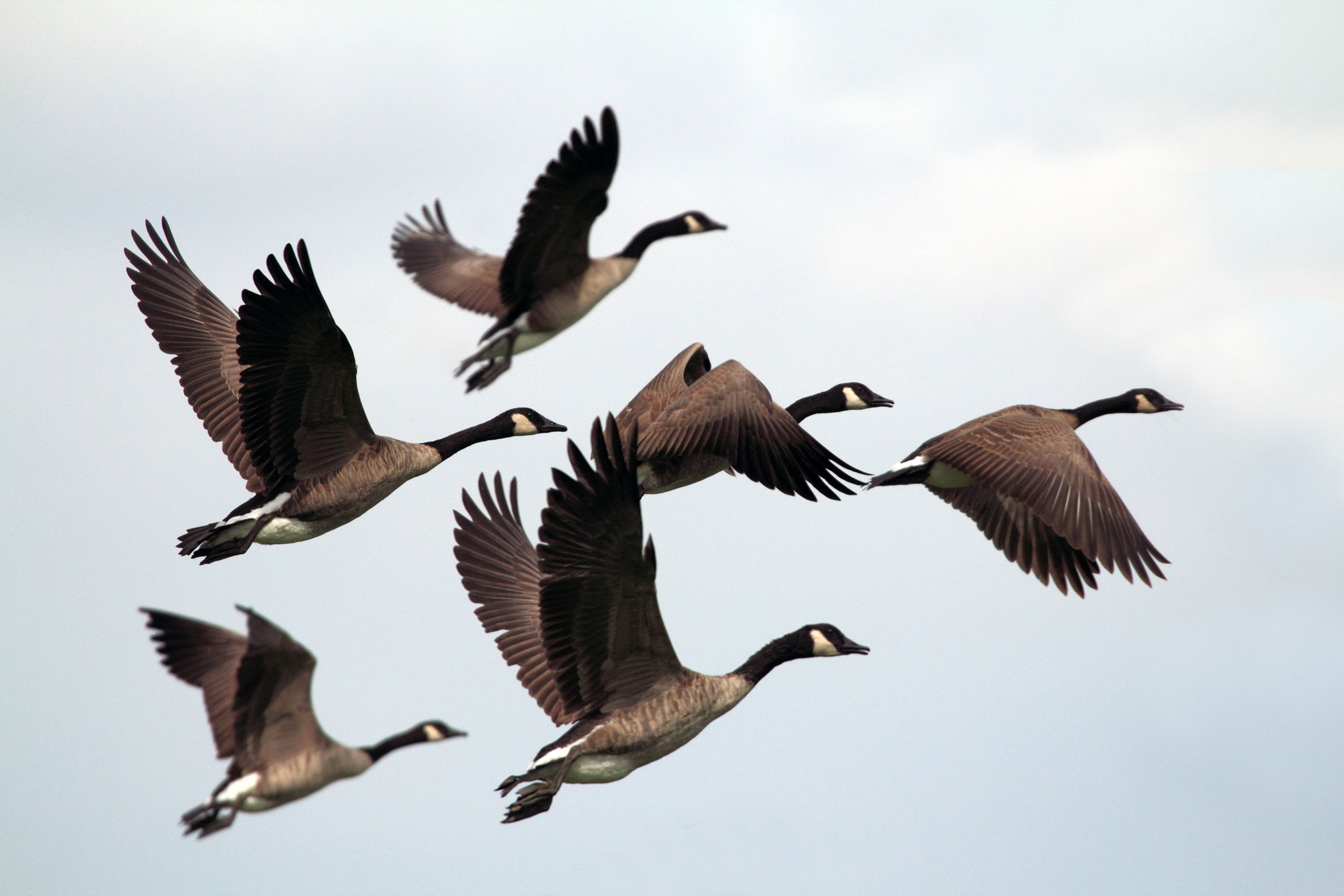
Birds that feed in flocks commonly retire together into roosts. The reasons for roosting communally are not always obvious, but there are some likely benefits. In winter especially, it is important for birds to keep warm at night and conserve precious food reserves. One way to do this is to find a sheltered roost. Solitary roosters shelter in dense vegetation or enter a cavity – horned larks dig holes in the ground and ptarmigan burrow into snow banks – but the effect of sheltering is magnified by several birds huddling together in the roosts, as wrens, swifts, brown creepers, bluebirds, and anis do. Body contact reduces the surface area exposed to the cold air, so the birds keep each other warm. Two kinglets huddling together were found to reduce their heat losses by a quarter, and three together saved a third of their heat. The second possible benefit of communal roosts is that they act as "information centers." During the day, parties of birds will have spread out to forage over a very large area. When they return in the evening some will have fed well, but others may have found little to eat. Some investigators have observed that when the birds set out again next morning, those birds that did not feed well on the previous day appear to follow those that did. The behavior of common and lesser kestrels may illustrate different feeding behaviors of similar birds with different roosting habits. The common kestrel hunts vertebrate animals in a small, familiar hunting ground, whereas the very similar lesser kestrel feeds on insects over a large area. The common kestrel roosts and hunts alone, but the lesser kestrel roosts and hunts in flocks, possibly so one bird can learn from others where to find insect swarms. Finally, there is safety in numbers at communal roosts since there will always be a few birds awake at any given moment to give the alarm. But this increased protection is partially counteracted by the fact that mass roosts attract predators and are especially vulnerable if they are on the ground. Even those in trees can be attacked by birds of prey. The birds on the edge are at greatest risk since predators find it easier to catch small birds perching at the margins of the roost.

Surrealism was an artistic and literary movement in the 20th century. It’s goal was to liberate thought, language, and human experience from the oppressive boundaries of rationalism.
It was founded by the poet André Breton in Paris in 1924. Breton had studied medicine and psychiatry and was well-versed in the psychoanalytic writings of Sigmund Freud. He was particularly interested in the idea that the unconscious mind (which produces dreams) was the source of artistic creativity. Breton also intended surrealism to be a revolutionary movement capable of unleashing the people’s minds from the rational order of society.
Each artist relied on their own motives that arose through their dreams or unconscious mind. Many surrealists have used automatic drawing or writing. Automatism refers to creating art without conscious thought, accessing material from the unconsciousness as part of the creative process. Surrealists have also drawn inspiration from mysticism and ancient cultures.
Some of the most known surrealists were André Breton, Joan Miró, Salvador Dalí, René Magritte, Frida Kahlo, Yves Tanguy, Max Ernst and Meret Oppenheim.

Cinnamon is a sweet, fragrant spice produced from the inner bark of trees of the genus Cinnamomum, which is native to the Indian sub-continent. It was known in biblical times, and is mentioned in several books of the Bible, both as an ingredient that was mixed with oils for anointing people’s bodies, and also as a token indicating friendship among lovers and friends. In ancient Rome, mourners attending funerals burnt cinnamon to create a pleasant scent. Most often, however, the spice found its primary use as an additive to food and drink. In the Middle Ages, Europeans who could afford the spice used it to flavour food, particularly meat, and to impress those around them with their ability to purchase an expensive condiment from the exotic’ East. At a banquet, a host would offer guests a plate with various spices piled upon it as a sign of the wealth at his or her disposal. Cinnamon was also reported to have health benefits, and was thought to cure various ailments, such as indigestion.
Toward the end of the Middle Ages, the European middle classes began to desire the lifestyle of the elite, including their consumption of spices. This led to a growth in demand for cinnamon and other spices. At that time, cinnamon was transported by Arab merchants, who closely guarded the secret of the source of the spice from potential rivals. They took it from India, where it was grown, on camels via an overland route to the Mediterranean. Their journey ended when they reached Alexandria. European traders sailed there to purchase their supply of cinnamon, then brought it back to Venice. The spice then travelled from that great trading city to markets all around Europe. Because the overland trade route allowed for only small quantities of the spice to reach Europe, and because Venice had a virtual monopoly of the trade, the Venetians could set the price of cinnamon exorbitantly high. These prices, coupled with the increasing demand, spurred the search for new routes to Asia by Europeans eager to take part in the spice trade.
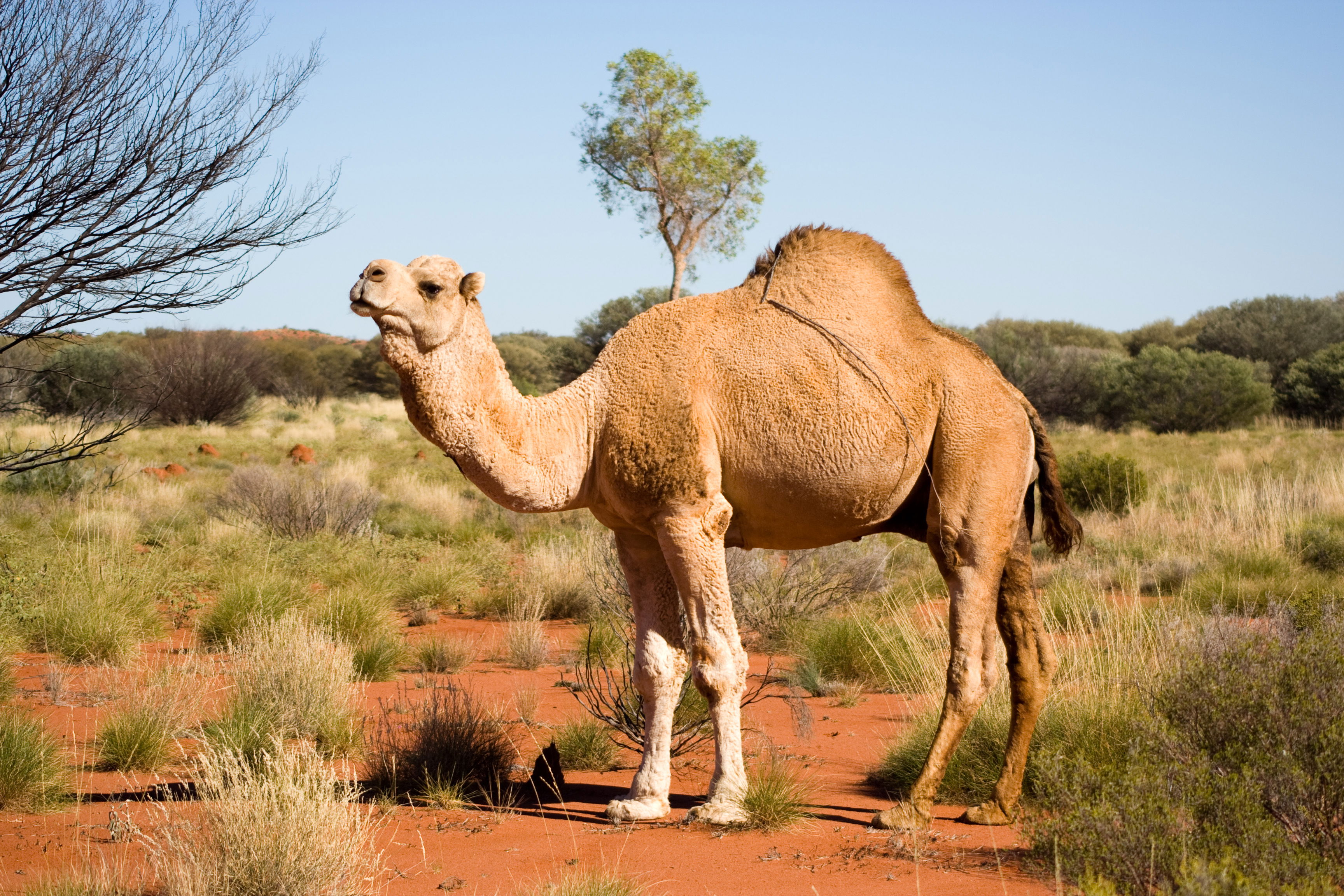
The dromedary (Camelus dromedarius), also known as the dromedary camel, Arabian camel, or one-humped camel, is a large camel, of the genus Camelus, with one hump on its back. It is the tallest of the three species of camel; adult males stand 1.8–2.4 m (5 ft 11 in – 7 ft 10 in) at the shoulder, while females are 1.7–1.9 m (5 ft 7 in – 6 ft 3 in) tall. Males typically weigh between 400 and 690 kg (880 and 1,520 lb), and females weigh between 300 and 540 kg (660 and 1,190 lb). The species' distinctive features include its long, curved neck, narrow chest, a single hump (compared with two on the Bactrian camel and wild Bactrian camel), and long hairs on the throat, shoulders and hump. The coat is generally a shade of brown. The hump, 20 cm (7+7⁄8 in) tall or more, is made of fat bound together by fibrous tissue. Dromedaries are mainly active during daylight hours. They form herds of about 20 individuals, which are led by a dominant male. They feed on foliage and desert vegetation; several adaptations, such as the ability to tolerate losing more than 30% of its total water content, allow it to thrive in its desert habitat. Mating occurs annually and peaks in the rainy season; females bear a single calf after a gestation of 15 months. The dromedary has not occurred naturally in the wild for nearly 2,000 years. It was probably first domesticated in the Arabian Peninsula about 4,000 years ago, or in Somalia where there are paintings in Laas Geel that figure it from 5,000 to 9,000 years ago. In the wild, the dromedary inhabited arid regions, including the Sahara Desert. The domesticated dromedary is generally found in the semi-arid to arid regions of the Old World, mainly in Africa and the Arabian Peninsula, and a significant feral population occurs in Australia. Products of the dromedary, including its meat and milk, support several North African tribes; it is also commonly used for riding and as a pack animal.

A lecture (from Latin: lectura 'reading') is an oral presentation intended to present information or teach people about a particular subject, for example by a university or college teacher. Lectures are used to convey critical information, history, background, theories, and equations. A politician's speech, a minister's sermon, or even a business person's sales presentation may be similar in form to a lecture. Usually the lecturer will stand at the front of the room and recite information relevant to the lecture's content. Though lectures are much criticised as a teaching method, universities have not yet found practical alternative teaching methods for the large majority of their courses. Critics point out that lecturing is mainly a one-way method of communication that does not involve significant audience participation but relies upon passive learning. Therefore, lecturing is often contrasted to active learning. Lectures delivered by talented speakers can be highly stimulating; at the very least, lectures have survived in academia as a quick, cheap, and efficient way of introducing large numbers of students to a particular field of study. Lectures have a significant role outside the classroom, as well. Academic and scientific awards routinely include a lecture as part of the honor, and academic conferences often center on "keynote addresses", i.e., lectures. The public lecture has a long history in the sciences and in social movements. Union halls, for instance, historically have hosted numerous free and public lectures on a wide variety of matters. Similarly, churches, community centers, libraries, museums, and other organizations have hosted lectures in furtherance of their missions or their constituents' interests. Lectures represent a continuation of oral tradition in contrast to textual communication in books and other media. Lectures may be considered a type of grey literature.
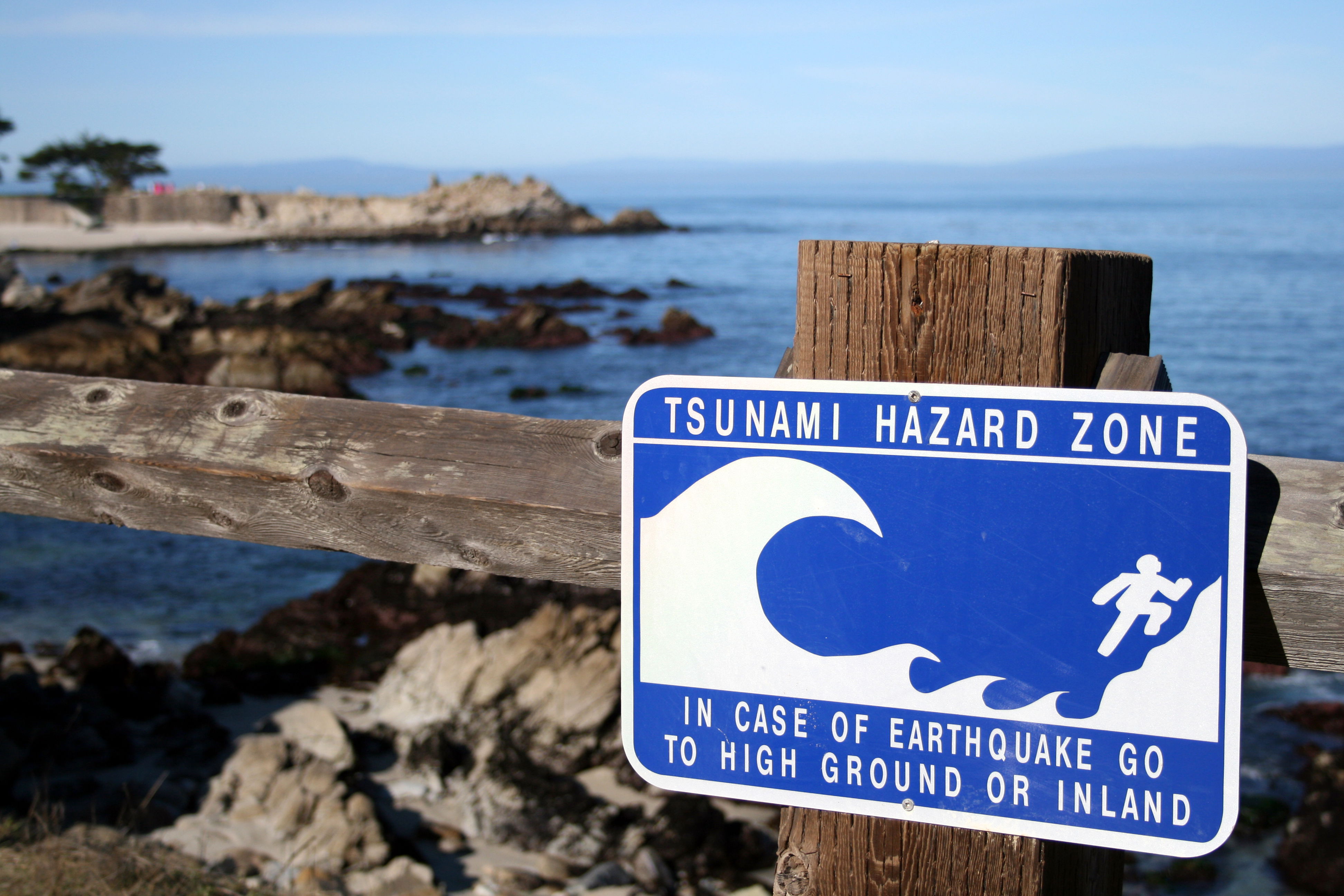
The 2011 Tōhoku earthquake and tsunami occurred at 14:46 JST (05:46 UTC) on 11 March. The magnitude 9.0–9.1 (Mw) undersea megathrust earthquake had an epicenter in the Pacific Ocean, 72 km (45 mi) east of the Oshika Peninsula of the Tōhoku region, and lasted approximately six minutes, causing a tsunami. It is sometimes known in Japan as the "Great earthquake disaster of East Japan" among other names. The disaster is often referred to in both Japanese and English as simply 3.11 (read san ten ichi-ichi in Japanese). It was the most powerful earthquake ever recorded in Japan, and the fourth most powerful earthquake in the world since modern record-keeping began in 1900. The earthquake triggered powerful tsunami waves that may have reached heights of up to 40.5 meters (133 ft) in Miyako in Tōhoku's Iwate Prefecture, and which, in the Sendai area, traveled at 700 km/h (435 mph) and up to 10 km (6 mi) inland. Residents of Sendai had only eight to ten minutes of warning, and more than a hundred evacuation sites were washed away. The snowfall which accompanied the tsunami and the freezing temperature hindered rescue works greatly, for instance, Ishinomaki, the city with most deaths, was 0°C (32°F) as the tsunami hit. The official figures released in 2021 reported 19,747 deaths, 6,242 injured, and 2,556 people missing, and a report from 2015 indicated 228,863 people were still living away from their home in either temporary housing or due to permanent relocation.

Molecular biology is the branch of biology that concerns the molecular basis of biological activity in and between cells, including molecular synthesis, modification, mechanisms and interactions. The central dogma of molecular biology describes the process in which DNA is transcribed into RNA, which is then translated into protein. William Astbury described molecular biology in 1961 in Nature, as: ...not so much a technique as an approach, an approach from the viewpoint of the so-called basic sciences with the leading idea of searching below the large-scale manifestations of classical biology for the corresponding molecular plan. It is concerned particularly with the forms of biological molecules and [...] is predominantly three-dimensional and structural – which does not mean, however, that it is merely a refinement of morphology. It must at the same time inquire into genesis and function. Some clinical research and medical therapies arising from molecular biology are covered under gene therapy whereas the use of molecular biology or molecular cell biology in medicine is now referred to as molecular medicine. Molecular biology also plays important role in understanding formations, actions, and regulations of various parts of cells which can be used to efficiently target new drugs, diagnose disease, and understand the physiology of the cell.

On July 20. in Moscow, President Vladimir Putin inspected a prototype of a new Sukhoi fifth-generation fighter jet on Tuesday that Russia unveiled at its annual MAKS air show with an eye on export markets. The warplane, given the project name "Checkmate", is likely to be touted as a rival to the U.S. F-35 stealth fighter, said Oleg Panteleyev, head of the Aviaport analytical agency. The warplane is expected to take to the skies in 2023 with a first batch due to be produced in 2026, Yury Slyusar, head of the United Aircraft Corporation told reporters. Russia plans to produce 300 of the aircraft over 15 years once serial production begins, he said. Rostec, Russia's state aerospace and defence conglomerate, said the plane was hard to detect and would have low operating costs. Rostec's chief, Sergei Chemezov, said it would cost $25 million to $30 million, the RIA news agency reported. Moscow expected demand from nations in the Middle East, Asia Pacific region and Latin America, he said.

When you think of cancer treatments, chemotherapy and radiation probably come to mind. That may change soon. A lot has happened in recent years to transform how the disease is, and will be, treated. As a result, folks with cancer and their doctors have more options to pick from, with more on the way. One thing that makes cancer tough to fight is that its cells can dodge your immune system. Your body either doesn’t see them as threats, or it simply can’t work hard enough to fight them. But some new immunotherapy drugs “mark” these cells so that they’re easier to find. These medicines can also make your body's defenses stronger so they can attack tumors. This type of treatment is already fighting some forms of cancer. Many more drugs are in the works. The FDA has approved a form of gene therapy called CAR T-cell therapy. It uses some of your own immune cells, called T cells, to treat your cancer. Doctors take the cells out of your blood and change them by adding new genes so they can better find and kill cancer cells. Right now, the drug, called tisagenlecleucel (Kymriah) is approved for treatment of children and young adults up to age 25 with B-cell acute lymphoblastic leukemia who haven’t gotten better with other treatments. But scientists are working on a version of CAR T-cell therapy for adults and for other kinds of cancer. Tisagenleleucel and axicabtagene (Yescarta) are both approved for treatment of certain types of B-cell lymphoma in adults that has not improved with other treatments. The FDA recently approved a new treatment called brexucabtagene autoleucel (Tecartus) for patients with mantle cell lymphoma that has not improved with other treatments or has come back after treatments.

The video assistant referee (VAR) is a match official in association football who reviews decisions made by the head referee with the use of video footage and headset for communication. This is specifically in order to minimize human errors causing substantial influence on match results. Following extensive trialling in a number of major competitions, VAR was first written into the Laws of the Game by the International Football Association Board (IFAB) in 2018. Operating under the philosophy of "minimal interference, maximum benefit", the VAR system seeks to provide a way for "clear and obvious errors" and "serious missed incidents" to be corrected. There are four categories of decisions that can be reviewed: -Goal/no goal – attacking team commits an offence, ball out of play, ball entering goal, offside, handball, offences and encroachment during penalty kicks. -Penalty/no penalty – attacking team commits an offence, ball out of play, location of offence, incorrect awarding, offence not penalised. -Direct red card – denial of obvious goal-scoring opportunity, serious foul play, violent conduct/biting/spitting, using offensive/insulting/abusive language or gestures. All straight red cards are subject to review. -Mistaken identity in awarding a red or yellow card.

The Great Recession was a period of marked general decline (recession) observed in national economies globally that occurred between 2007 and 2009. The scale and timing of the recession varied from country to country (see map). At the time, the International Monetary Fund (IMF) concluded that it was the most severe economic and financial meltdown since the Great Depression. One result was a serious disruption of normal international relations. The causes of the Great Recession include a combination of vulnerabilities that developed in the financial system, along with a series of triggering events that began with the bursting of the United States housing bubble in 2005–2012. When housing prices fell and homeowners began to abandon their mortgages, the value of mortgage-backed securities held by investment banks declined in 2007–2008, causing several to collapse or be bailed out in September 2008. This 2007–2008 phase was called the subprime mortgage crisis. The combination of banks unable to provide funds to businesses, and homeowners paying down debt rather than borrowing and spending, resulted in the Great Recession that began in the U.S. officially in December 2007 and lasted until June 2009, thus extending over 19 months. As with most other recessions, it appears that no known formal theoretical or empirical model was able to accurately predict the advance of this recession, except for minor signals in the sudden rise of forecast probabilities, which were still well under 50%.

The Maya civilization was a Mesoamerican civilization developed by the Maya peoples, and noted for its logosyllabic script—the most sophisticated and highly developed writing system in pre-Columbian Americas—as well as for its art, architecture, mathematics, calendar, and astronomical system. The Maya civilization developed in the area that today comprises southeastern Mexico, all of Guatemala and Belize, and the western portions of Honduras and El Salvador. It includes the northern lowlands of the Yucatán Peninsula and the highlands of the Sierra Madre, the Mexican state of Chiapas, southern Guatemala, El Salvador, and the southern lowlands of the Pacific littoral plain. “Maya" is a modern term used to refer collectively to the various peoples that inhabited this area. They did not call themselves “Maya,” and did not have a sense of common identity or political unity. Today, their descendants, known collectively as the Maya, number well over 6 million individuals, speak more than twenty-eight surviving Mayan languages, and reside in nearly the same area as their ancestors.
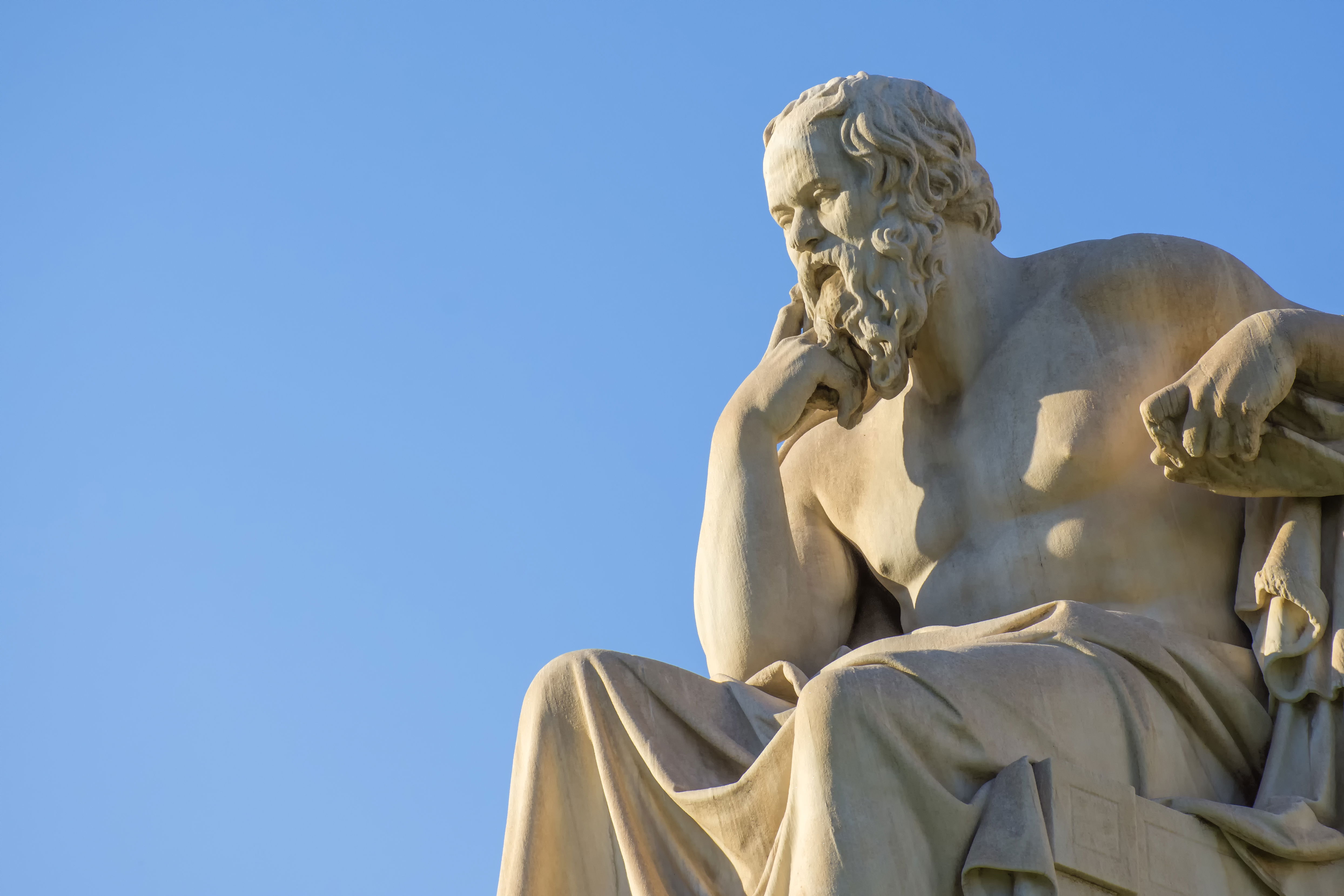
Philosophy is the study of general and fundamental questions, such as those about existence, reason, knowledge, values, mind, and language. Such questions are often posed as problems to be studied or resolved. Some sources claim the term was coined by Pythagoras (c. 570 – c. 495 BCE), others dispute this story, arguing that Pythagoreans merely claimed use of a preexisting term. Philosophical methods include questioning, critical discussion, rational argument, and systematic presentation. Historically, philosophy encompassed all bodies of knowledge and a practitioner was known as a philosopher. From the time of Ancient Greek philosopher Aristotle to the 19th century, "natural philosophy" encompassed astronomy, medicine, and physics. For example, Newton's 1687 Mathematical Principles of Natural Philosophy later became classified as a book of physics. In the 19th century, the growth of modern research universities led academic philosophy and other disciplines to professionalize and specialize. Since then, various areas of investigation that were traditionally part of philosophy have become separate academic disciplines, such as psychology, sociology, linguistics, and economics.

Hip hop music, also known as rap music, is a genre of popular music developed in the United States by inner-city African Americans and Latino Americans in the Bronx borough of New York City in the 1970s. It consists of a stylized rhythmic music that commonly accompanies rapping, a rhythmic and rhyming speech that is chanted. It developed as part of hip hop culture, a subculture defined by four key stylistic elements: MCing/rapping, DJing/scratching with turntables, break dancing, and graffiti writing. Other elements include sampling beats or bass lines from records (or synthesized beats and sounds), and rhythmic beatboxing. While often used to refer solely to rapping, "hip hop" more properly denotes the practice of the entire subculture. The term hip hop music is sometimes used synonymously with the term rap music, though rapping is not a required component of hip hop music; the genre may also incorporate other elements of hip hop culture, including DJing, turntablism, scratching, beatboxing, and instrumental tracks.

History of automobile-Development started as early as the 17th century with the invention of the first steam-powered vehicle, which led to the creation of the first steam-powered automobile capable of human transportation, built by Nicolas-Joseph Cugnot in 1769. Inventors began to branch out at the start of the 19th century, creating the de Rivas engine, one of the first internal combustion engines, and an early electric motor. Samuel Brown later tested the first industrially applied internal combustion engine in 1826. Development was hindered in the mid-19th century by a backlash against large vehicles, yet progress continued on some internal combustion engines. The engine evolved as engineers created two- and four-cycle combustion engines and began using gasoline as fuel. Production vehicles began appearing in 1887, when Carl Benz developed a petrol or gasoline-powered automobile and made several identical copies. Recent automobile production is marked by the Ford Model T, created by the Ford Motor Company in 1908, which became the first automobile to be mass-produced on a moving assembly line.

In modern physics, antimatter is defined as matter that is composed of the antiparticles (or "partners") of the corresponding particles of "ordinary" matter. Minuscule numbers of antiparticles are generated daily at particle accelerators—total production has been only a few nanograms—and in natural processes like cosmic ray collisions and some types of radioactive decay, but only a tiny fraction of these have successfully been bound together in experiments to form anti-atoms. No macroscopic amount of antimatter has ever been assembled due to the extreme cost and difficulty of production and handling. Theoretically, a particle and its anti-particle (for example, a proton and an antiproton) have the same mass, but opposite electric charge, and other differences in quantum numbers. For example, a proton has positive charge while an antiproton has negative charge. A collision between any particle and its anti-particle partner leads to their mutual annihilation, giving rise to various proportions of intense photons (gamma rays), neutrinos, and sometimes less-massive particle–antiparticle pairs. The majority of the total energy of annihilation emerges in the form of ionizing radiation. If surrounding matter is present, the energy content of this radiation will be absorbed and converted into other forms of energy, such as heat or light. The amount of energy released is usually proportional to the total mass of the collided matter and antimatter, in accordance with the notable mass–energy equivalence equation, E=mc2.
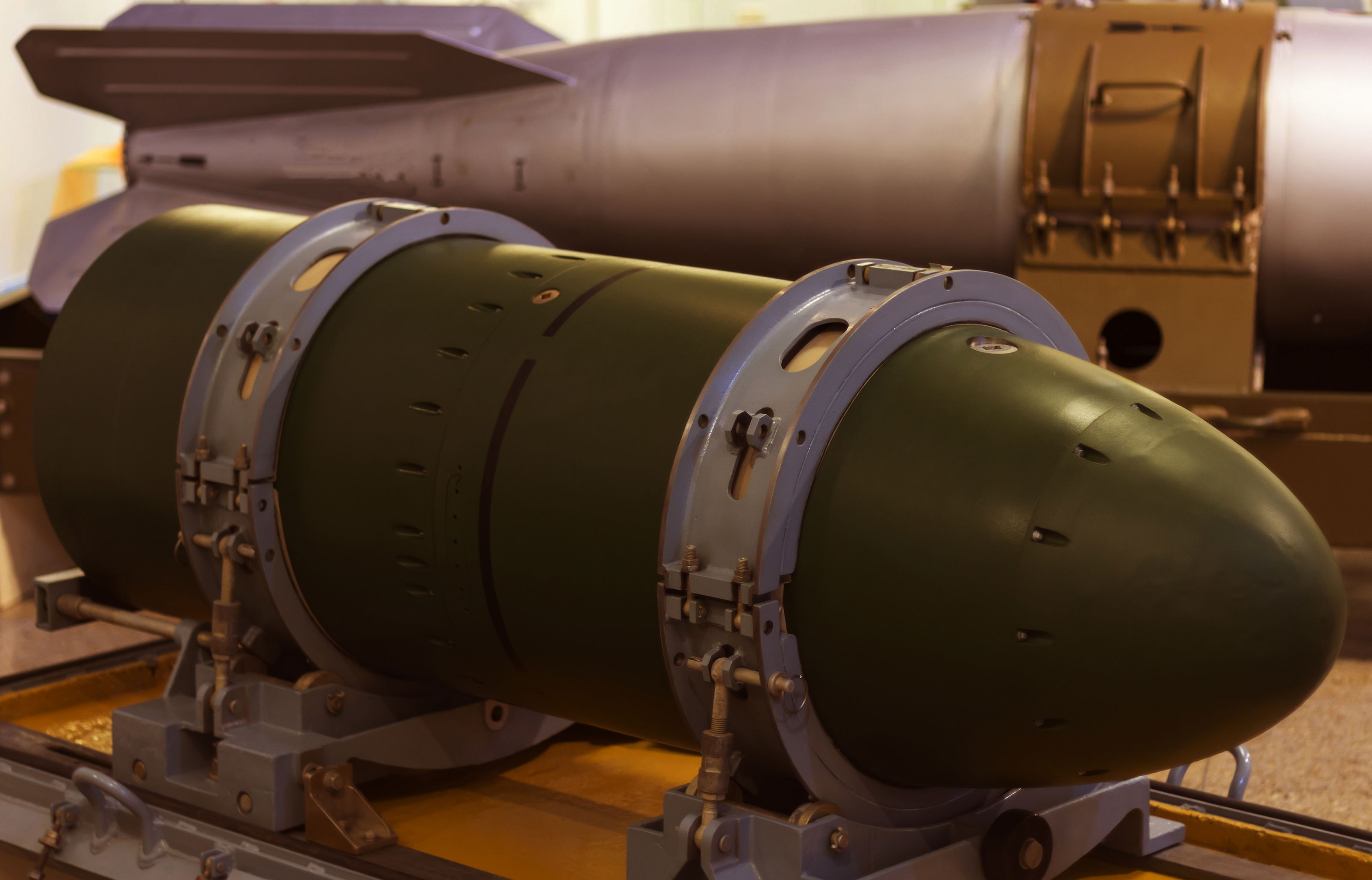
A nuclear weapon (also called an atom bomb, nuke, atomic bomb, nuclear warhead, A-bomb, or nuclear bomb) is an explosive device that derives its destructive force from nuclear reactions, either fission (fission bomb) or from a combination of fission and fusion reactions (thermonuclear bomb). Both bomb types release large quantities of energy from relatively small amounts of matter. The first test of a fission ("atomic") bomb released an amount of energy approximately equal to 20,000 tons of TNT (84 TJ). The first thermonuclear ("hydrogen") bomb test released energy approximately equal to 10 million tons of TNT (42 PJ). Nuclear bombs have had yields between 10 tons TNT (the W54) and 50 megatons for the Tsar Bomba (see TNT equivalent). A thermonuclear weapon weighing little more than 2,400 pounds (1,100 kg) can release energy equal to more than 1.2 million tons of TNT (5.0 PJ). A nuclear device no larger than a conventional bomb can devastate an entire city by blast, fire, and radiation. Since they are weapons of mass destruction, the proliferation of nuclear weapons is a focus of international relations policy. Nuclear weapons have been deployed twice in war, by the United States against the Japanese cities Hiroshima and Nagasaki in 1945 during World War II.

Guinness World Records, known from its inception in 1955 until 1999 as The Guinness Book of Records and in previous United States editions as The Guinness Book of World Records, is a reference book published annually, listing world records both of human achievements and the extremes of the natural world. The brainchild of Sir Hugh Beaver, the book was co-founded by twin brothers Norris and Ross McWhirter in Fleet Street, London, in August 1954. As of the 2021 edition, it is now in its 66th year of publication, published in 100 countries and 23 languages, and maintains over 53,000 records in its database. The international franchise has extended beyond print to include television series and museums. The popularity of the franchise has resulted in Guinness World Records becoming the primary international authority on the cataloguing and verification of a huge number of world records. The organisation employs record adjudicators to verify the authenticity of the setting and breaking of records.

The financial crisis of 2007–2008, also known as the global financial crisis (GFC), was a severe worldwide economic crisis. Prior to the COVID-19 recession in 2020, it was considered by many economists to have been the most serious financial crisis since the Great Depression. Lax financial regulation, excessive risk-taking by banks, and the bursting of the United States housing bubble culminated in a plummet in valuations of mortgage-backed securities which were tied to American real estate. Financial institutions worldwide suffered severe damage, reaching a climax with the bankruptcy of Lehman Brothers on September 15, 2008 and a subsequent international banking crisis. The financial risk-taking that underpinned the crisis was explicitly incentivized via government intervention in the housing and financial markets. After the onset of the crisis, governments deployed massive bail-outs of financial institutions and other palliative monetary and fiscal policies to prevent a collapse of the global financial system. The crisis sparked the Great Recession which resulted in increases in unemployment and suicide and decreases in institutional trust and fertility, among other things. The recession was a significant precondition for the European debt crisis. In 2010, the Dodd–Frank Wall Street Reform and Consumer Protection Act was enacted in the US as a response to the crisis to "promote the financial stability of the United States". The Basel III capital and liquidity standards were also adopted by countries around the world.